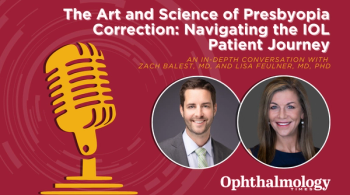
Good initial experience seen with dual-optic single-piece IOL
The Synchrony dual-optic single-piece IOL (Visiogen) performed well in a small initial study of this lens. The visual results were good; there were no major complications; no glare and halos after implantation; and patient satisfaction was high, according to George Beiko, MD, FRCS, who reported his experience at the American Society of Cataract and Refractive Surgery annual meeting.
The Synchrony dual-optic single-piece IOL (Visiogen) performed well in a small initial study of this lens. The visual results were good; there were no major complications; no glare and halos after implantation; and patient satisfaction was high, according to George Beiko, MD, FRCS, who reported his experience at the American Society of Cataract and Refractive Surgery annual meeting.
The IOL's construction may contribute to the good results. Dr. Beiko, of St. Catharine's, Ontario, Canada, described the lens' components:
- Posterior stabilizers that allow the lens to center in the eye and prevent decentration.
- Pillars that maintain the IOL in the open position and accentuate the movement of the anterior optic.
- Displacement limiters that prevent the two optics from coming into contact with each other.
To be candidates for the IOL implant, patients had to be more than 50 years of age, have a cataract, and no astigmatism or other corneal or retinal pathologies. Intraoperatively, Dr. Beiko noted that the capsulorhexis must be 4.5 to 5 mm to cover the anterior optic. The IOL is inserted using an injector through an incision that ranges from 3.6 to 3.8 mm; the IOL itself is almost 10 mm in size.
Thus far, 13 patients have had 1 month of follow-up, 10 patients have had 3 months of follow-up, and six patients have been followed for 6 months. One month after implantation, the spherical equivalent was slightly myopic and by 6 months slightly hyperopic.
"There were no major complications. Pigment dispersion occurred in one patient," Dr. Beiko said. "My patients are very happy. My first patients were 85 years old and they were ecstatic with their distance and near vision. There have been no reports of glare and halos."
He noted that the specific results are part of the FDA trial and could not be divulged at this time.
Newsletter
Don’t miss out—get Ophthalmology Times updates on the latest clinical advancements and expert interviews, straight to your inbox.


















































.png)


